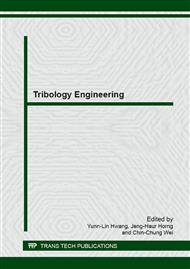p.286
p.292
p.298
p.303
p.307
p.311
p.317
p.323
p.328
Study of Thermal Expansion of a Vertical Motion Ball-Screw System Operated at High Rotational Speed
Abstract:
A ball-screw system is widely used in high speed transmission platforms. High transmission speed brings high frictional force, heat and thermal expansion occurring on contact areas of ball, screw and nut. Positioning error of platform is affected by the thermal expansion during linear transmission. A vertical motion of ball-screw driving system was used for high speed transmission test. Thermal expansion of screw and positioning error were measured for discussion their effects. Cyclic vertical motion during a long transmission distance, 2 km, will integrate thermal heat to ball, screw and nut, thermal expansion of screw is also occurred. From experiments, temperature rising and thermal expansion of screw and nut were recorded and calculated for estimate elongation and positioning error of a vertical motion high speed ball-screw. Positioning error is not totally respected thermal elongation effects of screw and nut owing to contact forces caused by wear and thermal expansion at contact areas comparing to the heavy axial load is relative small in a vertical motion ball-screw system. Therefore, the structure stiffness is not affected significantly by thermal effect and wear.
Info:
Periodical:
Pages:
307-310
Citation:
Online since:
April 2015
Authors:
Keywords:
Price:
Сopyright:
© 2015 Trans Tech Publications Ltd. All Rights Reserved
Share:
Citation:


